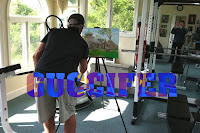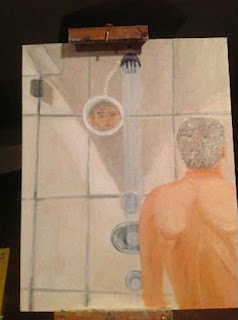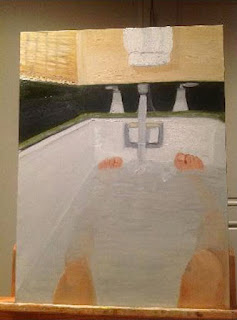It’s been a busy couple of months. I went to Boston to help promote my husband’s nerdy board game, set up a lecture series (see "
The Blue and the Grey"), celebrated a birthday, and had seven interviews. And while the majority of the interviews were phone or internet based, I traveled over 2,000 miles for one of them. It took a whole day to fly there, two nights in a hotel, and a whole day to fly back. And the museum paid for it all! So although I didn’t get the job, today I honor Cody, Wyoming: a vibrant little town outside Yellowstone National Park and the birthplace of legendary abstract expressionist painter Jackson Pollock.
 |
Cody, Wyoming seen from the Whitney Gallery of Western Art at the Buffalo Bill Historical Center in 2009.
Buffalo Bill Historical Center photo by Chris Gimmeson. |
Jackson Pollock grew up in the West. He was born in Cody in 1912 and lived in Arizona and California before moving to New York City with his brother Charles. The pair studied under famed regionalist painter Thomas Hart Benton, but Jackson soon began to experiment with abstraction. In 1947, he completed the first of the action paintings that would define his mature style. In 1956,
Time magazine dubbed him “Jack the Dripper.” Thanks to his groundbreaking poured, dribbled, and splattered works, Pollock became the first American recognized as a modern master abroad. He helped shift the heart of the art world from Paris to New York.
 |
| Jackson Pollock, Number 1A, 1948, 1948, oil and enamel paint on canvas, 172.7. x 264.2 cm. |
I didn’t choose one of those paintings though. I chose
The Blue Unconscious, a monumental work completed in the summer of 1946, right on the cusp of Pollock’s notorious “drip” period.
 |
| Jackson Pollock, The Blue Unconscious, 1946, oil on canvas, 213.4 x 142.1 cm. |
The Blue Unconscious is the largest of seven paintings in Pollock’s “Sounds in the Grass” series. Based on the environment of his new Long Island home, it’s painted in an “all-over” style that suggests wide ocean vistas, expansive marshland, and the spacious Western skies of his childhood (the blue in
The Blue Unconscious?). But Pollock seems to have focused more on the life than on the landscape. Mixing imagery and abstraction, he suggests a microcosm of dogs, insects, birds, plant life, and sea creatures. I think I can even make out a face or two. It reminds me of the animated energy of Keith Haring, but more obscured.
 |
| Keith Haring, Stones 5, 1989, lithograph, 76 x 56.5cm. |
And that’s where the unconscious in
The Blue Unconscious comes in. European art movements like surrealism, cubism, and fauvism inspired Pollock. “I am particularly impressed,” he stated of the newly emigrated artists living in New York, “with their concept of the source of art being the unconscious.” So he internalized and universalized his subject matter. And although the imagery may look garbled, his work reflects the spirit of nature better than any single representational image can.
The Blue Unconscious looks like Picasso's cubism painted in the colors of Matisse.
Right: Pablo Picasso, Guernica, 1937, oil on canvas, 349 x 776 cm.
Left: Henri Matisse, Femme au chapeau (Woman with a Hat),1905, oil on canvas, 80.65 x 59.69 cm.
Until last year, you could have seen
The Blue Unconscious at Houston’s Museum of Fine Art where it had been on loan since 2007. But tomorrow, the painting will be auctioned off in New York as part of Sotheby’s Contemporary Art Evening Auction (Seriously, Sotheby’s? You call a 67-year-old painting contemporary?!). Just six months after the auction house set a Pollock record with
Number 4, 1951,
The Blue Unconscious is estimated to bring in $20 to $30 million. So ready your unlimited financial reserves! It promises to be a rousing event! And if
The Blue Unconscious is too rich for your blood, maybe you could pick up John Currin’s
Lydian or, my personal favorite, Dan Colen’s
53rd & 3rd.
Right: John Currin, Lydian, 2013, oil on canvas, 71.1 x 50.8 cm.
Left: Dan Colen, 53rd & 3rd, 2008, chewing gum and paper on canvas, 152.4 x 240 cm.


























